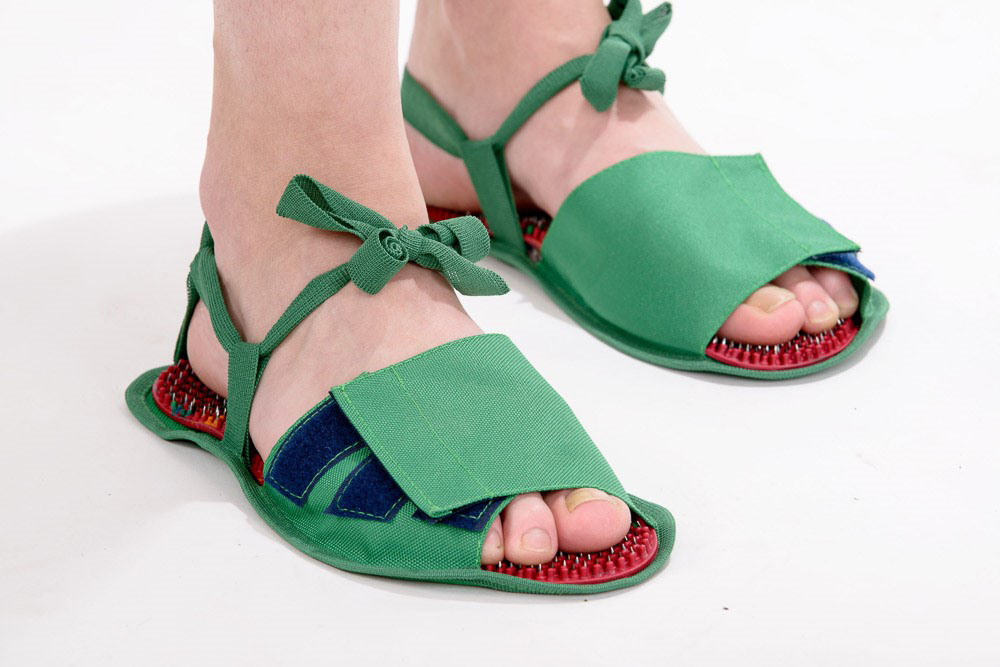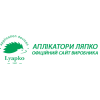Lyapko's application therapy in rehabilitation after undergoing COVID-19
1 Is rehabilitation after undergoing COVID-19 indicated?
2 Changes in the lungs with coronavirus
3 Postcoid syndrome or long covid
4 When can you start rehabilitation?
7 Methods of using Lyapko's application therapy for rehabilitation after undergoing covid
Is rehabilitation after undergoing COVID-19 indicated?
The transfer of COVID-19, even in a mild form, does not pass without leaving a trace for the lungs, as well as other organs and systems of the body. Therefore, rehabilitation is required for absolutely all patients who have had this disease.
In a quarter of patients, coronavirus infection can lead to the development of pneumonia. After undergoing such a serious inflammatory process, the body needs competent rehabilitation for full recovery.
Disturbances in the work of the respiratory system lead to a lack of oxygen in the body, which negatively affects the work of all organs and systems.
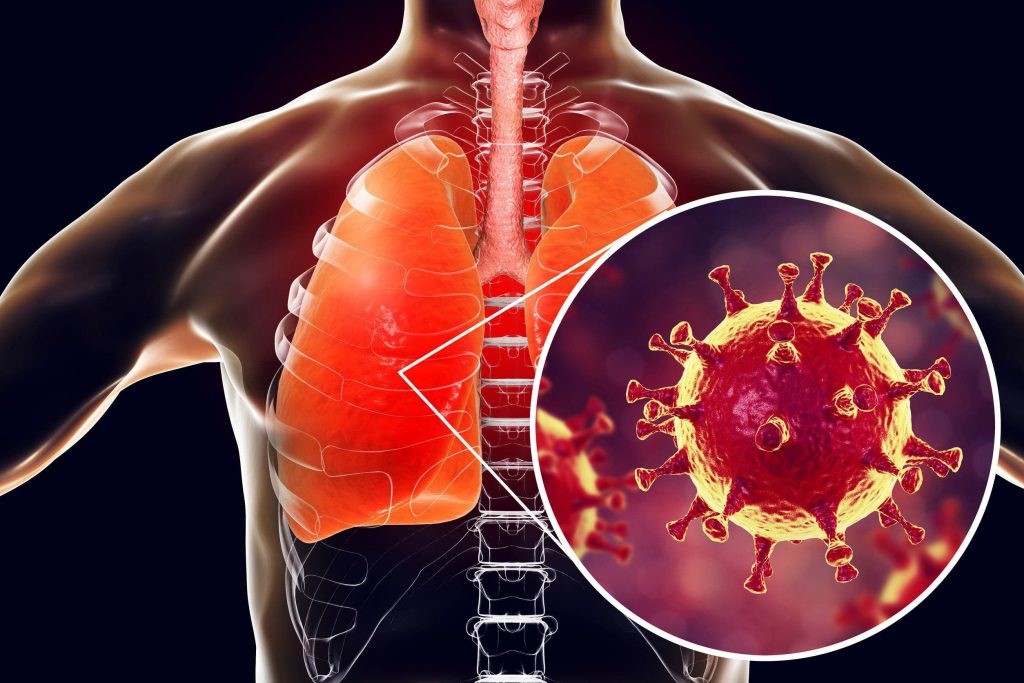
Changes in the lungs with coronavirus
First, the virus infects the upper respiratory tract, then it can descend into the lungs and cause the development of viral pneumonia.
The virus destroys the walls of the alveoli, this leads to disruption of the gas exchange processes in them, and also in the alveoli accumulates inflammatory exudate. This process can lead to the replacement of the affected areas with dense connective tissue that is not capable of stretching, which is called pulmonary fibrosis. Fibrosis is the occurrence of scarring and scarring. If small areas of the lungs are affected, scarring does not affect lung function. If the process covers large areas, then the lungs cannot fully perform the respiratory function, their vital volume decreases, irreversible changes in lung function occur, respiratory failure, which can lead to disability.
The development of pulmonary fibrosis leads to shortness of breath, especially after exercise, decreased performance up to disability, dizziness, dry cough, chest pain.
To avoid such undesirable consequences, recovery measures (rehabilitation) are required after pneumonia and coronavirus.
The formation of pulmonary fibrosis takes at least three months. The formed fibrosis is irreversible, but at the stage of development of the process, fibrotic changes can decrease as a result of drug and physiotherapeutic methods of treatment.
Postcoid syndrome or long covid
These are the various health problems that remain with a person after recovery for more than 12 weeks. Some of them occur even during illness, for example: shortness of breath, cough, or taste changes. Others appear after recovery: insomnia, depression, dizziness, or trouble concentrating.
The most common post-ovarian complications
Deterioration of general health: weakness, fever above 37 ° C, body pain, shortness of breath, cough.
From the side of the cardiovascular system: complaints of palpitations, heaviness in the region of the heart.
From the nervous system: peripheral neuropathy - tingling or numbness of the hands, feet and other parts of the body. Cognitive impairment: fog in the head, loss of concentration, or memory problems; headache, dizziness, sleep disturbance. Older people have a mental disorder (delirium): a person does not recognize others, does not remember his name, and suffers from confusion in his thoughts.
Psychological symptoms: anxiety, depression.
Complaints about the work of the gastrointestinal tract: abdominal pain, loose stools, decreased appetite, weight loss.
Almost all patients have liver damage - changes in its function and a pronounced increase in liver enzymes. This may be due to the intake of a large number of medications.
From the musculoskeletal system: complaints of pain in joints, muscles.
From the side of ENT organs: loss of taste, smell, ringing and pain in the ears, sore throat, dizziness.
Skin rash.
When can you start rehabilitation?
How badly a person was sick, depends on his state of health after recovery. People who are admitted to the hospital require longer and more intensive rehabilitation than those who were ill at home. But even people who don't need rehabilitation can do a few things to feel better.
The presence of such symptoms: shortness of breath at rest, fatigue, dry cough, attacks of dizziness, decreased saturation, etc. indicates the persistence of changes in the state and functioning of the lungs.
The rehabilitation program is aimed at eliminating these symptoms. Rehabilitation should start as early as possible. You can start working on restoring the body after a coronavirus infection, pneumonia with the permission of a doctor after the final relief of the acute inflammatory process and the normalization of body temperature.
To achieve the necessary results, an individual approach is important in choosing a set of rehabilitation measures, taking into account the severity of the disease, the nature of pneumonia, the extent of lung lesions, gender, age, weight, the presence of concomitant diseases and other factors.
As a rule, after obtaining permission from the attending physician, rehabilitation is scheduled for 20-25 days after the start of treatment.
In terms of time, the coronavirus recovery program is designed for 2-12 weeks.
It will take more time to recover from a severe illness: 6 - 12 months.
After suffering pneumonia, rehabilitation should be completed in courses of 10 days with intervals of 3-5 days.
The main tasks of rehabilitation after pneumonia are:
- increased blood flow and lymph flow in the lungs for resorption of inflammatory exudate and prevention of the development of pulmonary fibrosis;
- ensuring maximum excretion of sputum;
- strengthening the respiratory muscles, restoring normal breathing parameters;
- elimination of chronic fatigue syndrome;
- restoration of the work of the cardiovascular, nervous and other systems of the body;
- impact on psychological status (anxiety);
- restoration of cognitive abilities.
Recommended: breathing exercises; Exercise therapy; inhalation; massotherapy; diet; physiotherapy, work and rest regimen.
Physiotherapy treatment
At the stage of rehabilitation treatment, to activate the immune system, eliminate residual inflammatory foci in the lungs, correct concomitant syndromes, physiotherapeutic treatment methods are widely used: aeroionotherapy, halotherapy, balneotherapy, low-intensity laser therapy, low-frequency magnetotherapy, ultrasound therapy, inductothermy, high-intensity magnetic stimulation, acupuncture, phototherapy. application therapy Lyapko et al.
Lyapko application therapy
Lyapko application devices should be classified as immunostimulants (not of chemical origin!). They gently normalize the immune system and help the body resist infections and adverse environmental factors.
They are one of the methods of reflexology and can be considered as an independent section of physiotherapeutic treatment. Lyapko's application therapy refers to non-drug methods of treatment.
Lyapko applicators in various modifications (plates, rollers, applique belts, applique tapes) are an original, powerful device with many health-improving therapeutic capabilities.
Their action is based on the principles of traditional Chinese medicine - superficial multi-needle acupuncture, as well as general physiological mechanisms of life.

Applicator mechanisms of action
The high health-improving effect of Lyapko applicators is due to a combination of intense reactions:
- reflex-mechanical;
- galvanic-electrical;
- immunological.
Application therapy has a pronounced analgesic and antispasmodic effect. Improves blood circulation, lymph flow, microcirculation, reduces tissue edema. It activates the tissue mechanisms of immune defense, increases the level of its own opiate peptides and antistress hormones in the blood, reduces the sensitivity of pain receptors, has a positive psychoemotional effect and, as a result, stimulates the general adaptive mechanisms of a person. Contacting the skin, the applicator's needles stimulate the release of a person's internal drugs, including his “internal doctor” in the work.
Applicators are widely used in hospitals, health centers and sanatoriums. Ease of use, safety, high efficiency with minimal effort allow us to recommend applicators for independent use at home.
It is important to note that local (local) improvement of blood circulation during application therapy occurs without additional stress on the heart, since the work of the peripheral circulation is enhanced, and the heart is resting at this time. This is very important for all categories of patients and, especially, with ischemic heart disease, circulatory failure of 1–2 degrees, and elderly people.
The therapeutic effect of the applicators is enhanced if they are applied to the skin pre-moistened with water, hypertonic solution or on a gauze napkin with a decoction of medicinal herbs, water-based medicines. After removing the applicator, all the pores of the skin at the site of its application are opened and the application of medicinal oils, ointments and compresses is most effective.
Methods of using Lyapko's application therapy for rehabilitation after undergoing covid
With pneumonia, Lyapko's application therapy is prescribed from 3-4 days - the end of the first week from the onset of the disease in the absence of an elevated body temperature and continues the entire period of treatment and rehabilitation.
Application areas for pneumonia (Fig. 1): main 4; auxiliary 3, 5, 13, 14; additional 21, 23, 25, 29, 31.

Fig. 1
Influence on psychological status.
To improve the psycho-emotional state, relieve anxiety, it is recommended to use applicators on the cervical-collar and interscapular regions (stress zones). Also, application in the evening to any area of the body, depending on the problem, helps to restore sleep.
Polyneuropathy of the extremities, pain in the joints, in the muscles.
If the problem is related to polyneuropathy, damage to the joints of the upper extremities, then it is necessary to act with applicators on the cervical-collar spine, from where innervation goes to the upper extremities, then to the entire limb or to the area of the diseased joint.
If there are problems in the lower extremities, then applicators should be applied to the lumbosacral spine, from where innervation goes to the lower extremities, then to the entire limb or to the area of the diseased joint.
You can act simultaneously or alternately.
For example: on the back area with a flat applicator, and roll the limb with application rollers or fix the application belts: "Magic tape" Health ", belt" Universal M ", belt" Kid "..
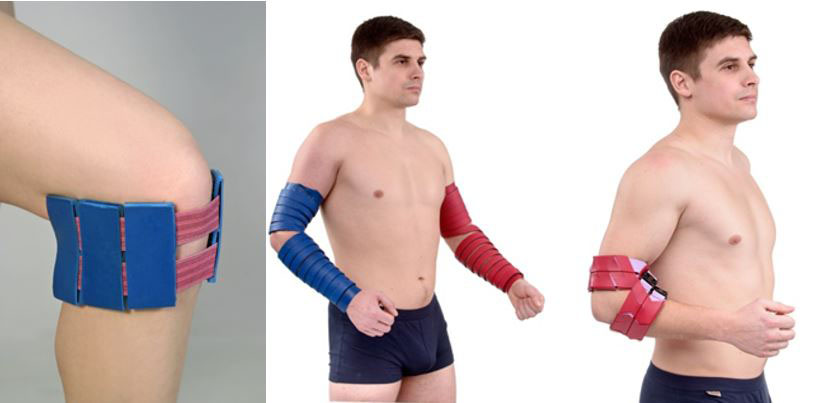
It is recommended to use large flat applicators on the back area: Applicator "Large rug", "Large needle massage mat", "Chance 6.2x4", "Narodny".
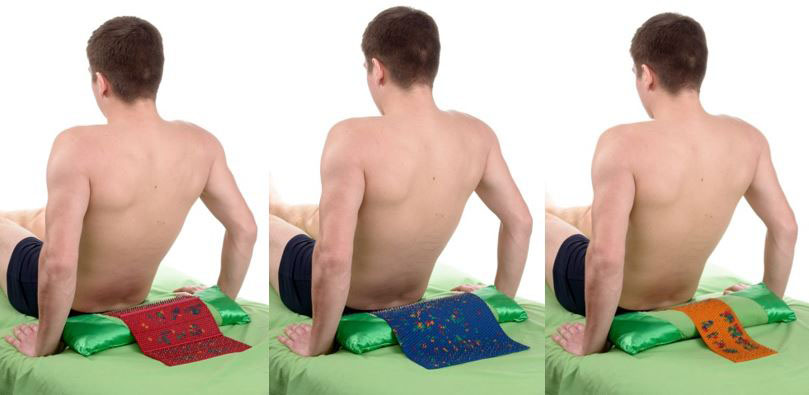
"Chamomile M", "Quadro". The larger the exposure area, the better the effect.

It is also possible to use smaller flat applicators: "Needle massage pillow", "Insoles plus", "Chance", "Sputnik plus", which are placed on the zone of the projection of the lungs. In addition to the back area, to enhance the effect, it is recommended to apply applicators to the auxiliary zones on the front surface of the body (zones 13, 14).
The exposure time is 20-30 minutes, the course of treatment is 10-14 days, which can be repeated after a break after 1-2 weeks.
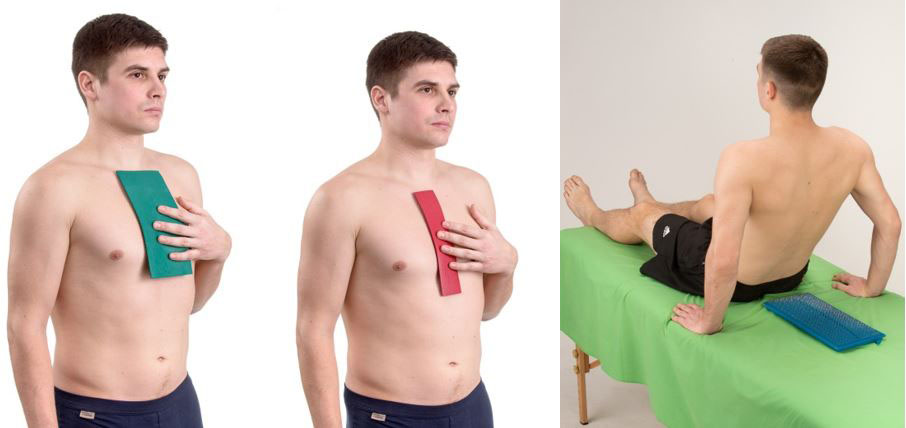
In addition to flat applicators, you can roll the area of the back, front surface of the body, arms, legs with the "Large M roller" or "Universal M roller" until a uniformly pink color of the skin appears. They can also be used to warm up the body before a massage.
First, roll it along the spine, along the intercostal space on one side, until a uniformly pink color appears. Then, roll the second side in the same way. The exposure time is 3–7–10 minutes, depending on the individual reaction of the skin.
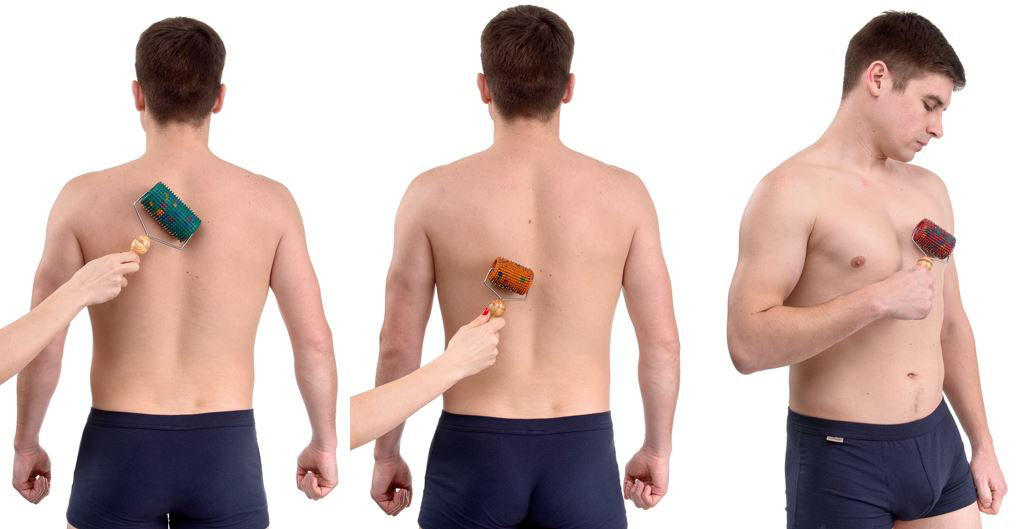
Run-in with "Large roller M", "Universal roller M", "Face roller M", "Needle ball" problem areas on the arms and legs. Rolling in the palms for 10-15 minutes improves cognitive functions, fine motor skills, and gives a calming effect.

To improve the functioning of the abdominal organs and intestines, Lyapko's application therapy is indicated on the abdomen, the projection zone of the liver, where the largest amount of lymphoid tissue is located, which is responsible for the functioning of the immune system. For this it is recommended to use large and medium flat applicators.
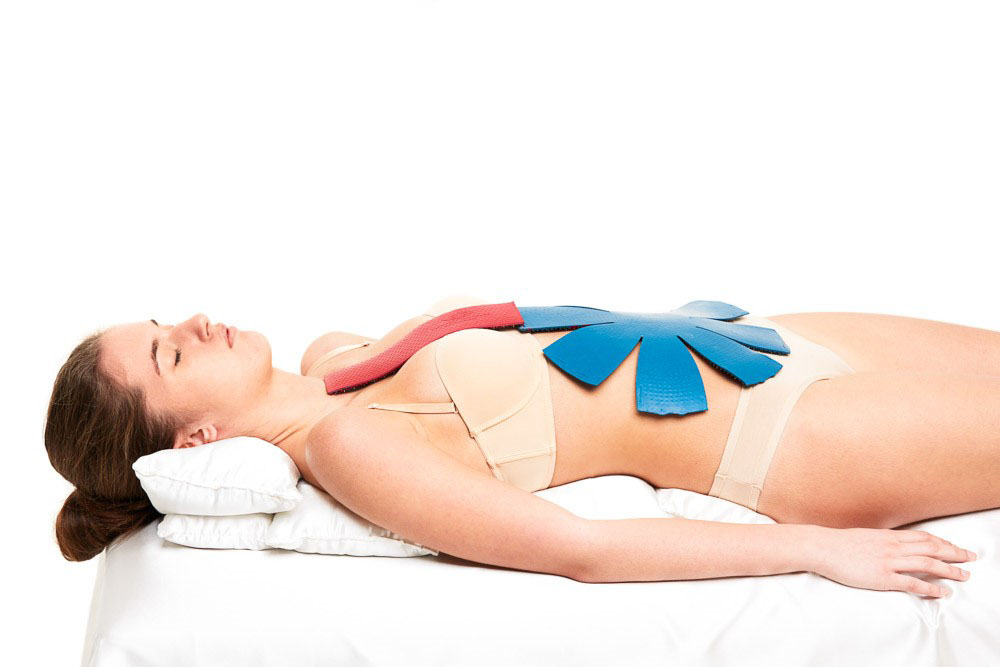
And also application belts: "Kid", "Universal M", "Sputnik" on the lower thoracic and lumbosacral spine, as well as on the anterior abdominal wall (simultaneously or alternately).

You can also wrap these zones with the "Magic tape" Health "for 20-30 minutes or roll these zones with application rollers for 10-15 minutes.

Lyapko's application therapy on the abdominal area is used both as an independent procedure and as a preparation for relaxing the muscles of the anterior abdominal wall before visceral massage of the abdomen according to A.T. Ogulov (massage of internal organs through the anterior abdominal wall), lymphatic massage of the abdomen according to O. Shishova. ., and etc.
Such procedures improve the functioning of internal organs, relieve congestion, inflammation in them, restore the functioning of the lymphatic system, and increase immunity.
To improve lung function, relieve muscle tension, and with pain in the extremities, it is recommended to massage the whole body: back, front surface of the chest, buttocks, limbs, head. You can do both manual massage and using the "Pharaoh" massager, which is used to work through a thin tissue or over the body, lubricated with oil or cream. The duration of the massage and its intensity determines the desired effect. A short massage, 3-5-7 minutes, has a tonic (stimulating) effect.
Long-term, up to 15 minutes. and more, massage promotes complete muscle relaxation, creates a sedative (calming) effect. During the session, you should perform circular movements in a clockwise direction or longitudinal - up and down. After the massage, we recommend laying on the flat applicator for rest and relaxation.
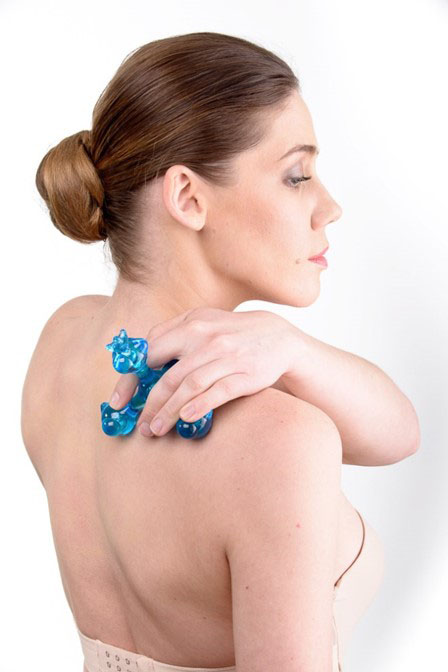
It is imperative to act on the feet with the "Insoles Plus" applicator, since the foot is a special reflexogenic zone of the body, on which all organs and systems are displayed.
Stimulating (tonic) effect - 5 - 7 - 10 minutes in the morning in an active motor mode (walking).
Starting position - standing on insoles or intensive "rolling" of an object (rolling pin, tennis ball or glass bottle) with a foot with an insole. To save time on the insoles, you can take a shower, combine with foot baths.
Calming (sedative) effect in the evening - 15 - 30 minutes of smooth, progressive, wave-like movements of the foot on the insole or "delicate" rolling of the object - starting position - sitting on a chair or lying in bed.
